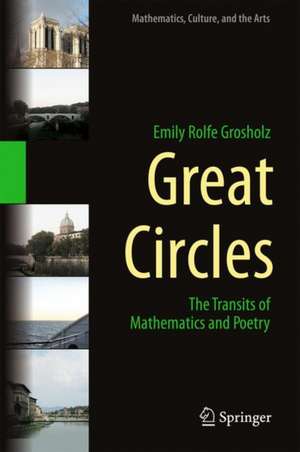Great Circles: The Transits of Mathematics and Poetry: Mathematics, Culture, and the Arts
Autor Emily Rolfe Grosholzen Limba Engleză Hardback – 23 noi 2018
The first part of the book is autobiographical, following the author through her discovery of these analogies, revealed by music, architecture, science fiction, philosophy, and the study of mathematics and poetry. The second part focuses on geometry, the circle and square, launching us from Shakespeare to Housman, from Euclid to Leibniz. The third part explores the study of dynamics, inertial motion and transcendental functions, from Descartes to Newton, and in 20th c. poetry. The final part contemplates infinity, as it emerges in modern set theory and topology, and in contemporary poems, including narrative poems about modern cosmology.
Preț: 311.66 lei
Nou
Puncte Express: 467
Preț estimativ în valută:
59.64€ • 64.98$ • 50.25£
59.64€ • 64.98$ • 50.25£
Carte disponibilă
Livrare economică 02-16 aprilie
Preluare comenzi: 021 569.72.76
Specificații
ISBN-13: 9783319982304
ISBN-10: 3319982303
Pagini: 368
Ilustrații: XII, 274 p. 42 illus., 31 illus. in color.
Dimensiuni: 155 x 235 x 18 mm
Greutate: 0.58 kg
Ediția:1st ed. 2018
Editura: Springer International Publishing
Colecția Springer
Seria Mathematics, Culture, and the Arts
Locul publicării:Cham, Switzerland
ISBN-10: 3319982303
Pagini: 368
Ilustrații: XII, 274 p. 42 illus., 31 illus. in color.
Dimensiuni: 155 x 235 x 18 mm
Greutate: 0.58 kg
Ediția:1st ed. 2018
Editura: Springer International Publishing
Colecția Springer
Seria Mathematics, Culture, and the Arts
Locul publicării:Cham, Switzerland
Cuprins
Preface.- I. A Life in Mathematics and Poetry.- II. The Homestead.- III.- Shipping Out.- IV. The Sky's the Limit!.- Coda.
Recenzii
“The author is mostly writing for a broad audience, so much of the mathematics is presented so as to be accessible to a not necessarily mathematical audience. … Great Circles provides an interesting example of the human side of mathematics.” (Jason M. Graham, Mathematical Reviews, August, 2019)
Notă biografică
Emily Grosholz is Edwin Erle Sparks Professor of Philosophy at the Pennsylvania State University. She earned her PhD from Yale University and her BA from the University of Chicago. Her most recent philosophy book, Starry Reckoning: Reference and Analysis in Mathematics and Cosmology, was awarded the 2017 Fernando Gil International Prize for Philosophy of Science. She has published eight books of poetry and ten authored or edited books of philosophy, and has written many literary reviews and essays.
Textul de pe ultima copertă
This volume explores the interaction of poetry and mathematics by looking at analogies that link them. The form that distinguishes poetry from prose has mathematical structure (lifting language above the flow of time), as do the thoughtful ways in which poets bring the infinite into relation with the finite. The history of mathematics exhibits a dramatic narrative inspired by a kind of troping, as metaphor opens, metonymy and synecdoche elaborate, and irony closes off or shifts the growth of mathematical knowledge.
The first part of the book is autobiographical, following the author through her discovery of these analogies, revealed by music, architecture, science fiction, philosophy, and the study of mathematics and poetry. The second part focuses on geometry, the circle and square, launching us from Shakespeare to Housman, from Euclid to Leibniz. The third part explores the study of dynamics, inertial motion and transcendental functions, from Descartes to Newton, and in 20th c. poetry. The final part contemplates infinity, as it emerges in modern set theory and topology, and in contemporary poems, including narrative poems about modern cosmology.
The first part of the book is autobiographical, following the author through her discovery of these analogies, revealed by music, architecture, science fiction, philosophy, and the study of mathematics and poetry. The second part focuses on geometry, the circle and square, launching us from Shakespeare to Housman, from Euclid to Leibniz. The third part explores the study of dynamics, inertial motion and transcendental functions, from Descartes to Newton, and in 20th c. poetry. The final part contemplates infinity, as it emerges in modern set theory and topology, and in contemporary poems, including narrative poems about modern cosmology.
Caracteristici
Studies the intersections of mathematics and poetry over centuries Contains beautiful poems and photographs Explores the history of geometry, the infinitesimal calculus, and set theory


